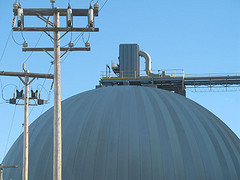 Just last year we noted that the U.S. was uniquely poised to become a major exporter of liquid natural gas (LNG). This week we saw another step in that direction as the Department of Energy (DOE) announced that it had conditionally authorized Oregon-based LNG Development Co., LLC (Oregon LNG) to export LNG to countries without a Free Trade Agreement with the U.S. Oregon LNG would export the domestically produced gas from its terminal in Warrenton, Oregon. The facility is authorized to export up to 1.25 billion standard cubic feet of LNG per day for the next 20 years, though the project is subject to final regulatory authorization and environmental review.
Just last year we noted that the U.S. was uniquely poised to become a major exporter of liquid natural gas (LNG). This week we saw another step in that direction as the Department of Energy (DOE) announced that it had conditionally authorized Oregon-based LNG Development Co., LLC (Oregon LNG) to export LNG to countries without a Free Trade Agreement with the U.S. Oregon LNG would export the domestically produced gas from its terminal in Warrenton, Oregon. The facility is authorized to export up to 1.25 billion standard cubic feet of LNG per day for the next 20 years, though the project is subject to final regulatory authorization and environmental review.
This announcement comes just as the DOE finalizes its overhaul of natural gas export reviews; in fact, Oregon LNG will be one of the final projects to meet with conditional approval. As of this week, the DOE will only issue final rulings after the Federal Energy Regulatory Commission (FERC) or another approved agency completes an environmental review of the project. Completion of this approval can be a lengthy and costly process—companies can pay up to $100 million to complete it, according to Reuters. Still, DOE’s procedural changes could to be the first step toward streamlining the approval process.
Although exports of LNG may be growing slowly, increased domestic production of natural gas in recent years has caused huge shifts in the domestic energy market. The U.S. Energy Information Administration reported Wednesday that coal imports fell more than 75 percent between in the past seven years. As more coal-fired power plants shut down, they are often replaced by advanced energy such as natural gas and renewables which along with domestic coal production helps to explain the dramatic fall in imports. At its peak in 2007, the U.S. was importing 30 million tons of coal to power plants across the country. By last year, that number had dropped to 7 million. The agency reported that the number of power plants using imported coal fell from 48 in 2006 to 13 in 2013.
According to a new survey of utility executives from Black & Veatch, 64 percent of respondents cited advanced energy, including natural gas and renewable energy, as the most likely “replacement energy source” for increasing demand and replacement capacity for retiring coal and nuclear power plants. “In some cases,” Jeff St. John, writing for Greentech Media, points out, “utilities can expect to build less central generation than what they’re losing, because distributed generation – mostly rooftop solar – is making up the difference.” See our discussion last week on utility-owned solar and how it might impact the larger solar market.
Natural gas and distributed solar are just two technologies that can reduce greenhouse gas emissions while growing the American economy. Download the new report from AEE that details 40 different technologies that can reduce carbon emissions in the U.S.
Featured photo courtesy of ariwriter and used under a Creative Commons License.
